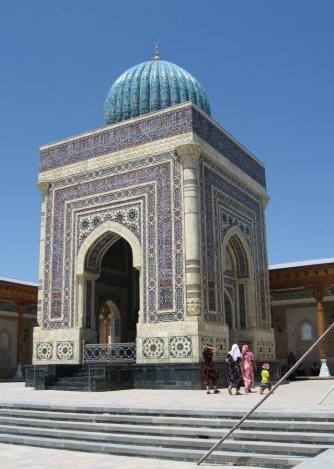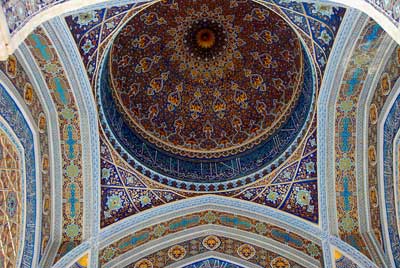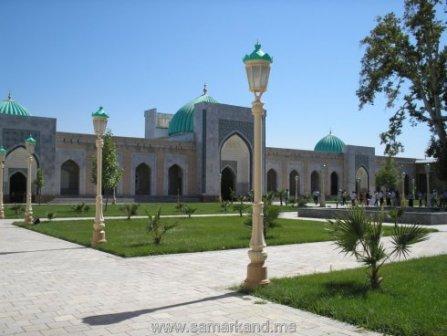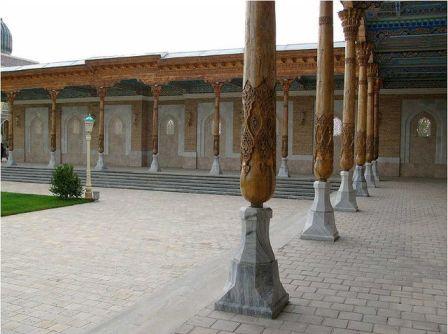|
Category
|
The memorial complex of Imam al-Bukhari
Abu Abdullah Muhammad ibn Ismail al-Bukhari - the famous theologian, the hadith collector (Hadith - the science of Hadith, reports about the sayings and deeds of Prophet Muhammad) and the author of the second most important book of the Muslims after the Koran "Al-Jomiy al-Saheeh" ("Secure book "). Imam Al-Bukhari was born in 810 in Bukhara. It is known that his great-grandfather was one of the first who converted to Islam. His father was one of the narrators of sacred traditions. When al-Bukhari was a child, his father died. Al-Bukhari remained in the care of his mother, who raised him. She was an educated woman who organized the training of boys different sciences. Muhammad was a shrewd, smart, possessed an extraordinary memory for his age. At the age of 7 he learned the whole Qur'an at the age of 10 years, he knew by heart a few thousand hadith. In the year 825 when he was 16 years old, al-Bukhari with his mother and older brother Ahmed went on pilgrimage to Mecca and Medina. After a pilgrimage to his mother's brother returned to Bukhara, and he traveled for many years in various Muslim countries, where he studied under famous theologians of the time.
In addition to his will, he came into conflict with the Takhirid’s ruler of Bukhara, Ahmad ibn Halid and was forced to move into the village Hartang near Samarkand, where he died in 870. Cemetery in the village Hartang (Payaryk district Samarkand region) has become the most revered and sacred place for pilgrimage. In the sixteenth century, next to the mausoleum of Imam al-Bukhari was built a small mosque and a planted plane trees. In the Soviet period this holy place for Muslims was forgotten, and the service is not implemented. Gradually, dilapidated mosque, but in 1954 she was destined to come back to life thanks to the visit of Indonesian President Sukarno. After a visit to Moscow, President Sukarno arrives in Tashkent and asked that he be allowed to worship the remains of the saint Imam al-Bukhari. The republican authorities, on hearing this, at first taken aback, because I had already forgotten who the Imam al-Bukhari and where his grave. In a hurry command was given: to immediately send a commission to Samarkand. The authorities could not deny the president Sukarno, because at the time of Khrushchev's initiative to establish the Soviet Union became the international relations with many countries, including the countries of the Islamic East, and therefore failure threatened international scandal. But when officers arrived at the place, they saw a very ugly picture of the mosque deserted, and at the grave of al-Bukhari is not even a headstone. And for a team of high officials, during the day, the mosque and the surrounding area, as they could, put in order, to the mosque in a hurry, even laid an asphalt track. In short, the mosque al-Bukhari took President Sukarno. And he bowed to the grave of the great scientist and honoring his memory was gone. Following President Sukarno in the Soviet Union came to the president of Somalia Madiba Keith, who also visited Tashkent, requested to give him the opportunity to visit the tomb of the saint Ismail al-Bukhari. After that, apparently on orders from the center, a mosque, Ismail al-Bukhari handed over to the Spiritual Administration of Muslims of Central Asia and Kazakhstan. And since then, once again began to visit the mosque praying.
Entrance to the complex through the entrance portal, equipped with a carved gates. On both sides of the main entrance to a memorial plate with Arabic and Latin script to build the complex. On the central axis of the complex stands the mausoleum of Ismail al-Bukhari in the form of a rectangular prism, square at the base area of 9x9 meters high 17 meters. The dome of the mausoleum double ribbed, decorated with blue tiles. The walls are decorated with mosaics, majolica, alabaster, onyx and granite, with floral and geometric patterns. In the center of the tomb of a light green onyx.
In the yard is a training center for the study of hadith. In the center of the courtyard is the pond - "Hauz" with ancient plane trees, next to which beats the source of healthy water. In order to study the deep and wide dissemination of the spiritual heritage of Imam al-Bukhari was created by an international fund, which in 2000 published his spiritual and educational magazine. Book of al-Bukhari used in madrasas and Islamic universities as a primary textbook for the study of the Sunnah (the traditions of the sacred) of the Prophet Muhammad. Mausoleum of Makhdumi Azam At the end of December 1994 Samarkand was the site of an international symposium dedicated to one of the famous Oriental thinkers XV-XVI centuries Sayed Ahmad Mavlono Jaloliddin Hodzhaga Kosoni (1461-1542). For his birthday in the ancient town Dahbed (15 km from Samarkand), which is located halfway from Samarkand to the Mausoleum of Imam al-Bukhari, has been renovated complex Makhdumi Azam. Proceedings of the famous scientist Upgrade "tariqa" (exercise) were considered progressive for its time, and as a sign of high respect and esteem theologian contemporaries called "Makhdumi Azam" ("Great Master"). This scientist - an active follower and continuer of ideas Bohouddin Naqshband. Its ancestors were respectable people - "Sayyid" - that is, descendants of the Prophet. Leading a frugal life, engaged in farming and gardening, Makhdumi Azam was a wonderful mentor. The most revered in the East, his writings on philosophy, theology, ethics, Islamic law (more than 30 works), some of them are united under the name "Majmuat ul-Risoli". According to him, religion and holy books were created for the moral perfection of man. "No man is made for religion, and religion for the people" - this statement was daring for its time. It called upon to be responsible for peace and order in the world to actively participate in ensuring the prosperity of the country. On the territory of the mausoleum is growing the holy tree. Four- stemand a huge, he is about 600 years, but it is still covered with leaves, in spite of the huge hollow of his roots. According to legend, the tree was moved by thought Makhdumi Azam from Iran. During prayer Makhdumi Azam chastised his disciples not to open his eyes. But one student did not obey. And he was opening the eyes in the dark an Iranian prison. At the cries of the prisoner guard came running, and possessed, in their opinion, the prisoner brought to the Iranian shah. A student tried to explain what is happening, what amused the Iranian ruler. He was ordered to tie "liar" to the tree, contemptuously remarked: "If this is your Sheikh Almighty, let him take you back ..." In the morning this place was not a murid (student) or wood - just a hole from the roots ... They say that shocked the Shah of Iran to be buried themselves in the feet of Hazrat (Holy). You will not even show his grave. And the Iranian mulberry grows still, surprising for its unusual shape and size. The scientist had a large number of followers, disciples. Among them are many of the statesmen, poets - such for example as Zahiriddin Muhammad Babur - the founder of the Mughal state, Janibek Sultan (later gave him a picturesque island Miankal), representatives of the royal Sheibanids dynasty. It should be noted that visiting these holy places of Muslims equates to a small Hajj. It's no wonder people say: "If Mecca - the heart of the Muslim world, Samarkand - his head". In preparing the articles used material sites and http://www.ziyonet.uz http://www.samarkand-foto.ru |
 In the village Hartang (Payaryk district, 25 km from Samarkand) is located one of the most revered pilgrimage sites in Islam - the mausoleum of Imam al-Bukhari.
In the village Hartang (Payaryk district, 25 km from Samarkand) is located one of the most revered pilgrimage sites in Islam - the mausoleum of Imam al-Bukhari. According to legend, he has collected hundreds of thousands of hadiths, of which 300 000 knew by heart. In these studies, he spent his life in '42. By writing his book, he started back in Basra and continued to write it for many years, which included, according to him, Hadith 1080 experts. In his 7275 book includes authentic hadith. An indicator of the reliability of the hadith is the reliability of the transmission channel and for each level, meaning moral character of the transmitter, allowing him to rely. Al-Bukhari gave a special importance of the establishment parties, which served as the primary source of transmission. In the "authentic" he included only those hadiths that are told by people who are direct witnesses to the act of the prophet. Imam al-Bukhari was working on his book for sixteen years.
According to legend, he has collected hundreds of thousands of hadiths, of which 300 000 knew by heart. In these studies, he spent his life in '42. By writing his book, he started back in Basra and continued to write it for many years, which included, according to him, Hadith 1080 experts. In his 7275 book includes authentic hadith. An indicator of the reliability of the hadith is the reliability of the transmission channel and for each level, meaning moral character of the transmitter, allowing him to rely. Al-Bukhari gave a special importance of the establishment parties, which served as the primary source of transmission. In the "authentic" he included only those hadiths that are told by people who are direct witnesses to the act of the prophet. Imam al-Bukhari was working on his book for sixteen years. By source of knowledge that he has written many books, including "Ta'rihi Kabir" ("The Great Story"). After writing "As-Sahih" he returned to Bukhara, and begins to teach anyone who wanted to learn, because we believe that the collective teaching people to read and write will be of great benefit to society. His prestige was so high that a hadith unknown to him, was popularly regarded as unreliable.
By source of knowledge that he has written many books, including "Ta'rihi Kabir" ("The Great Story"). After writing "As-Sahih" he returned to Bukhara, and begins to teach anyone who wanted to learn, because we believe that the collective teaching people to read and write will be of great benefit to society. His prestige was so high that a hadith unknown to him, was popularly regarded as unreliable. After Uzbekistan gained independence the memory of Imam Muhammad ibn Ismail al-Bukhari was restored. In 1998 in the village Hartang by initiative the President of Uzbekistan Islam Karimov was built the magnificent memorial complex, which includes a mausoleum, a mosque, library and madrassas. It involved the construction of the best builders and craftsmen of Samarkand, Tashkent, Bukhara, Khiva, Shakhrisabz, Andijan, Namangan and Kokand. In the same October 23 1998 in Samarkand hosted celebrations dedicated to the 1225th anniversary of the famous scientist.
After Uzbekistan gained independence the memory of Imam Muhammad ibn Ismail al-Bukhari was restored. In 1998 in the village Hartang by initiative the President of Uzbekistan Islam Karimov was built the magnificent memorial complex, which includes a mausoleum, a mosque, library and madrassas. It involved the construction of the best builders and craftsmen of Samarkand, Tashkent, Bukhara, Khiva, Shakhrisabz, Andijan, Namangan and Kokand. In the same October 23 1998 in Samarkand hosted celebrations dedicated to the 1225th anniversary of the famous scientist. On the left side of the courtyard is located a mosque, “honaka” and gallery area of 786 sq.m. where can simultaneously to pray 1500 faithful. On the right side has a library and a museum with rare instances of handwritten and lithographed books on Islamic theology, gifts, government officials of various states, including part of the "kisva" - covered with the Kaaba in Mecca, which presented a memorial to the King of Saudi Arabia.
On the left side of the courtyard is located a mosque, “honaka” and gallery area of 786 sq.m. where can simultaneously to pray 1500 faithful. On the right side has a library and a museum with rare instances of handwritten and lithographed books on Islamic theology, gifts, government officials of various states, including part of the "kisva" - covered with the Kaaba in Mecca, which presented a memorial to the King of Saudi Arabia.














